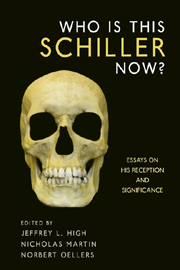Book contents
- Frontmatter
- Contents
- Foreword
- Acknowledgments
- List of Abbreviations
- Introduction: Why Is This Schiller [Still] in the United States?
- Part I Schiller, Drama, and Poetry
- 1 Lenz und Schiller. Die erlebnissymptomatische Dramensprache
- 2 Melancholy in Schiller's Dramas
- 3 Schillers Ästhetik der Trauer. Der Dichter als “elegischer” Lyriker und Dramatiker
- 4 Glühendes Wort zum Ideal über der versagenden Realität — zu Schillers Balladen
- 5 Zwischen Max Piccolomini und Buttler. Wallensteins Orts- und Zeitverluste
- Part II Schiller, Aesthetics, and Philosophy
- Part III Schiller, History, and Politics
- Part IV Schiller Reception — Reception and Schiller
- Part V Schiller Now
- Notes on the Contributors
- Index
5 - Zwischen Max Piccolomini und Buttler. Wallensteins Orts- und Zeitverluste
from Part I - Schiller, Drama, and Poetry
Published online by Cambridge University Press: 05 February 2013
- Frontmatter
- Contents
- Foreword
- Acknowledgments
- List of Abbreviations
- Introduction: Why Is This Schiller [Still] in the United States?
- Part I Schiller, Drama, and Poetry
- 1 Lenz und Schiller. Die erlebnissymptomatische Dramensprache
- 2 Melancholy in Schiller's Dramas
- 3 Schillers Ästhetik der Trauer. Der Dichter als “elegischer” Lyriker und Dramatiker
- 4 Glühendes Wort zum Ideal über der versagenden Realität — zu Schillers Balladen
- 5 Zwischen Max Piccolomini und Buttler. Wallensteins Orts- und Zeitverluste
- Part II Schiller, Aesthetics, and Philosophy
- Part III Schiller, History, and Politics
- Part IV Schiller Reception — Reception and Schiller
- Part V Schiller Now
- Notes on the Contributors
- Index
Summary
The current view in Schiller research is that Wallenstein's tragic end was above all a result of the machinations of the monarchist Octavio Piccolomini, but this is here subject to revision. Wallenstein fails, losing the place given to him by history and losing the time into which he was placed. He is the cause of his own failure: in him two vastly different modes of perception hold sway — the fatal idealism of Max Piccolomini and the murderous pragmatism of Buttler — and this eventually brings about his physical demise. The general view of this dynamic constellation of characters raises questions about Wallenstein's treachery and peaceful intentions, as well as, secondarily, about the moral qualities of Octavio Piccolomini.
SCHILLER HEUTE? WALLENSTEIN HEUTE? Es lässt sich darauf antworten: Der Dichter und sein Werk sind, was sie geworden sind, vor über 200 Jahren; sie sind als das einst Gewordene dauerhaft. Aber es lässt sich auch sagen: Kunstwerke sind nie das dauerhaft Abgeschlossene. Also bedürfen sie immer wieder der Beschreibung, Analyse und Interpretation, um ihre Bedeutung für die jeweilige Gegenwart zu bestimmen. Wer sich mit Schiller beschäftigt, tut es in der Regel nicht, weil er den Dichter für antiqu iert, für vorgestrig hält, sondern weil er für gewiss annimmt, dass er lebendig geblieben ist. Und wenn in der Gegenwart wiederholt wird, was in der Vergangenheit gesagt und geschrieben wurde oder auf der Bühne zu sehen war, dann spricht das nicht gegen das Gewesene, weder gegen das Werk noch gegen seine ins Heute mündende Rezeptionsgeschichte.
- Type
- Chapter
- Information
- Who Is This Schiller Now?Essays on his Reception and Significance, pp. 81 - 96Publisher: Boydell & BrewerPrint publication year: 2011

